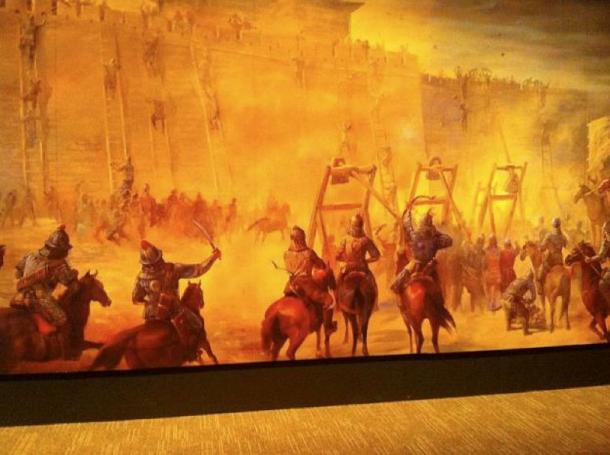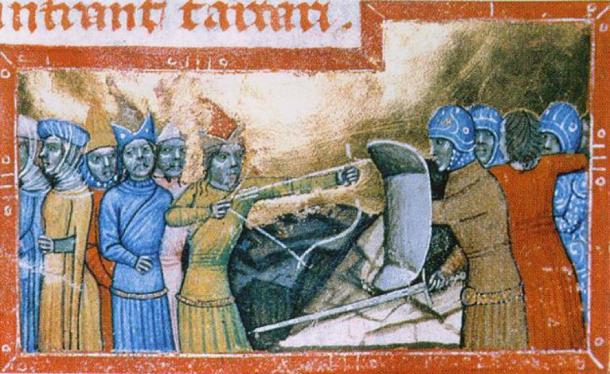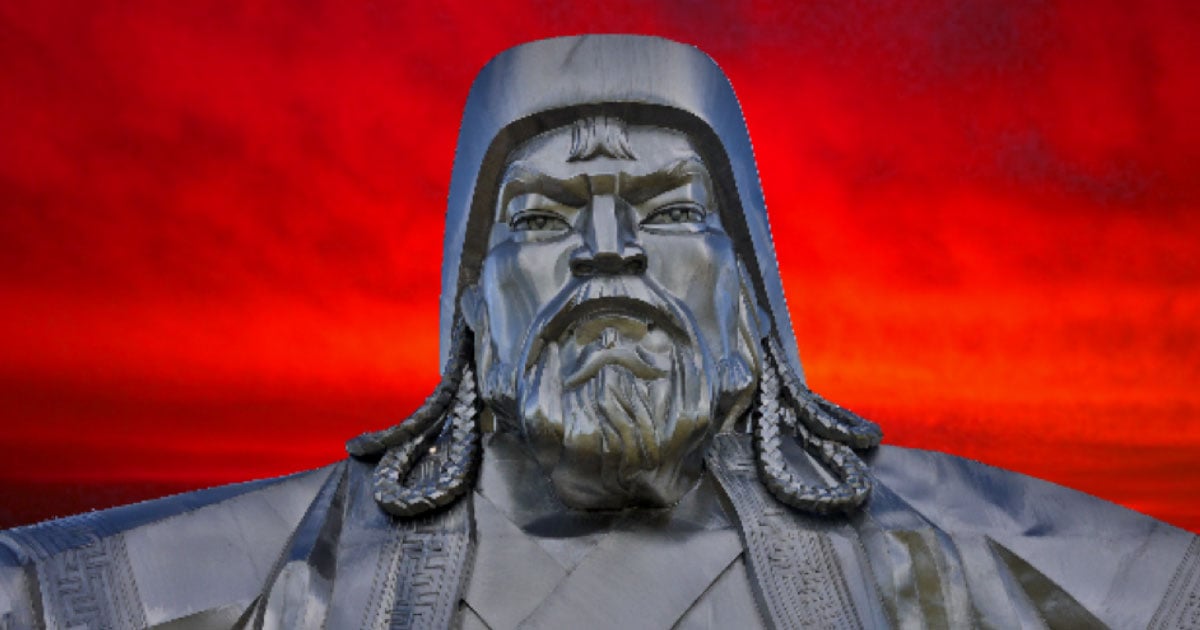The Genghis Khan Biography: Military Genius, Genocidal Maniac, Serial Abuser Of Women
Genghis Khan: the infamous 13th century Emperor of the Mongol Empire was one the most ferocious and ruthless people to have ever lived on planet Earth. If you read a Genghis Khan biography, it won’t take you long to see that his reign of fear and rivers of blood shadow the atrocities of Napoleon, Hitler, or Stalin - and not even women were beyond his ghastly reach.
The Mongol Empire conquered all of Asia and no enemy could withstand Genghis Khan and his bloodthirsty armies. His soldiers were said to be so strong that one Mongolian man could defeat ten enemy warriors. Genghis was responsible for over 40 million deaths, which at that time was equal to 11 percent of the world's population. In comparison, World War II is estimated to have killed around 60-80 million people, which was three percent of the world's population.

Genghis Khan proclaimed Khagan of all Mongols. Illustration from a 15th-century Jami' al-tawarikh manuscript. (Public Domain)
The Devil Had A Violent Upbringing
Viennese doctor Sigmund Freud (1856-1939) believed that the way parents dealt with children's basic sexual and aggressive desires determined how their personalities developed and whether or not they would end up well-adjusted as adults. With this in mind, note that when Genghis Khan was only 9 years old his father was killed by an enemy tribe and Genghis’ tribe expelled his mother, so she raised Genghis and his six brothers and sisters on her own.
Genghis' family suffered from extreme hunger and cold - it would appear those hardships made Genghis a hardened fighter. When Genghis was just ten years old, he fell into a dispute with his brother over a piece of food. This is where we see the first signs of his inner demons - he killed his brother for the food. Genghis was later enslaved by a rival clan, which further fueled his hate. When he escaped slavery all hell broke loose.
- Genghis Khan: What Transformed Temujin Borjigin into an Unstoppable Force Bent on World Domination?
- The Golden Horde and the Mongol Mission to Conquer Europe
- Jebe: Genghis Khan’s Would-be Assassin Becomes His Sharpshooting General
Genghis Gains Power
By his early 20s, he had established himself as a formidable warrior and as the leader of a small army of supporters he forged alliances with the heads of important tribes. By 1206 AD he had successfully consolidated the steppe confederations under his banner and turned his attention to conquest. His army of nomadic tribesmen traveled in a juggernaut with scaling ladders, battering rams, four-wheeled mobile shields, and bombhurlers. Gathering prisoners as it progressed, Genghis used them as soldiers or in his slave-labor working force who built roads and traveled ahead of Genghis as suicide troops, filling up the moats and taking the full force of the enemy defenses.

Mural of siege warfare, Genghis Khan Exhibit, Tech Museum San Jose, 2010. (Bill Taroli/CC BY 2.0)
Genghis Khan was a man of reason within his own empire, where he let the people live happy lives so long as they followed his rules. If you were silly enough to break one of those rules, Genghis Khan would cruelly punish you. For example, when the governor of one of the cities in the Khwarazmian Empire killed Genghis’ caravan traders he sent 100,000 Mongols to the Khwarazmian Empire and killed tens of thousands of people, including the governor. Renowned for his horrendous torturing techniques, he poured boiling hot molten silver down people’s throats and into their ears and noses. Genghis was also keen on watching enemy's backs being bent until the backbone snapped.
In the Persian city of Merv, regarded as the pearl of Asia, Genghis “ordered that, apart from 400 artisans, the whole population, including the women and children, should be killed, and no one, whether woman or man, be spared. To each Mongol soldier was allotted the execution of 300 or 400 Persians. So many had been killed by nightfall that the mountains became hillocks, and the plain was soaked with the blood of the mighty." (C. Hudson)
Historians today estimate that more than a million people were killed in less than a week. In one particularly brutal incident of Genghis Khan’s biography, he rounded up hundreds of Russian survivors and stacked them on top of one another on the ground before lowering a vast wooden gate on top of them. Then Genghis and the entire Mongol army had a huge banquet on the gate and as they ate and drank, Russians died beneath them from suffocation and pressure wounds.

Mongol horse archers. (Public Domain)
Captured Women “Beauty Pageants”
When Genghis occupied a new area he first enslaved all the strong young men and killed those he deemed too young or old to fight for his army. He was quoted as having said "The greatest pleasure is to vanquish your enemies and chase them before you, to rob them of their wealth and see those dear to them bathed in tears, to ride their horses and clasp to your bosom their wives and daughters.” Genghis Khan took pleasure in sleeping with the wives and daughters of the enemy chiefs and his army commanders believed him to have extraordinary sexual powers, witnessing him sleeping with many women every night.
Harold Lamb's 1927 book Genghis Khan: Emperor Of All Men, which 80 years after its publication remains the best-selling history book on the Mongolian warlord, lays claim to him being the most prolific fornicator the world has ever seen. Conquered women were raped, tortured, and murdered by his soldiers. But on fear of death the most “beautiful” women would be kept aside, untouched, to be presented to Khan in beauty pageants.
As his commanders tore huge lumps of nearly raw horsemeat, the women would be presented one by one and the “winner”, the most beautiful woman, would become his new wife. Having hundreds of wives from different nations, his Mongolian blood line was spread across all of Asia - which ensured a state of peace over the entire conquered Mongol Empire. It is hard to tell how many children Genghis had, but historians estimate that around eight percent of modern Asian men are his direct descendants.

The Mongol invasion of Hungary. The dismounted Mongols, with captured women are shown on the left and the Hungarians, with one saved woman, are depicted on the right. (Public Domain)
Because Genghis could have anything in the world he wanted, he chose women of the highest rank and those that filled his definition of beauty: “small noses, rounded hips, long silky hair, red lips and melodious voices” according to an article in the Daily Mail. It is known he measured women’s beauty in “carats” and if he rated them below a certain number they were sent to the tents of his officers to be raped then ‘discarded’.
- Ogedei Khan: Only His Death Could Save Europe from the Mongols
- Genghis Khan Not the Only Genes in Town - Genetic Founding Fathers of Asia were Mystery Men
- Palms Over Baghdad: Riches and Fear during the Mongol Invasion – Part I
The Final Chapter in the Genghis Khan Biography: Death And Disappearance Of The Devil
In just 20 years, Genghis ruled an empire twice the size of Rome's and changed the world forever. His Mongol Empire ended up ruling, or briefly conquering, large parts of modern day China, Mongolia, Russia, Azerbaijan, Armenia, Georgia, Iraq, Iran, Turkey, Kazakhstan, Kyrgyzstan, Uzbekistan, Pakistan, Tajikistan, Afghanistan, Turkmenistan, Moldova, South Korea, North Korea, and Kuwait.

The extent of the Mongol Empire c. 1207. (Khiruge/CC BY SA 4.0)
At the age of 65 years old, Genghis Khan died in 1227 AD. Mystery surrounds his death and scholars are still unable to determine what caused Genghis’ death or where his grave or tomb is situated. Some people believe that he fell from his horse while hunting; others say an enemy shot an arrow through his knee. Notwithstanding, the most told version of his death is that he was assassinated by a captured Chinese princess - which knowing what we know about Genghis, sounds the most fitting end.
Top Image: Detail of a Genghis Khan statue (Johnathon Shaw/CC BY NC SA 2.0) in front of a blood red sky. (CC0)
By Ashley Cowie
References
Andrews, E. (2014) “10 Things You May Not Know About Genghis Khan.” History. Available at: https://www.history.com/news/10-things-you-may-not-know-about-genghis-khan
Hudson, C. (2007) “Genghis Khan: The daddy of all lovers.” Daily Mail. Available at: https://www.dailymail.co.uk/news/article-456789/Genghis-Khan-The-daddy-lovers.html
Khan, R. (2010) “1 in 200 men direct descendants of Genghis Khan.” Discover. Available at: http://blogs.discovermagazine.com/gnxp/2010/08/1-in-200-men-direct-descendants-of-genghis-khan/
Mandal, D. (2016) “10 surprising things you should know about the Mongol soldier.” Realm of History. Available at: https://www.realmofhistory.com/2016/02/10/10-facts-you-should-know-about-the-mongol-soldier/
Sartore, M. (n.d.) “In Terms of Sheer Influence, Genghis Khan Had The Most Successful Love Life In Human History.” Weird History. Available at: https://www.ranker.com/list/private-life-of-genghis-khan/melissa-sartore
Szczepanski, K. (2018) “Genghis Khan and the Mongol Empire.” ThoughtCo. Available at: https://www.thoughtco.com/the-mongol-empire-195041




















Comments
Some day I would love to read an article on the actuall psycological profile of the Great Khan. I mean was he a Sociopath with some Psycopathic tendencies? Some day.